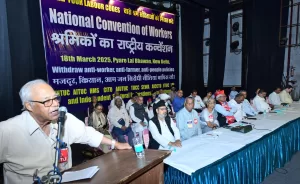Last year marked six decades since the publication of Rachel Carson’s seminal work Silent Spring, the book often credited with inspiring the modern environmental movement (at least in North America).
One impactful line from the book stands out as being even more true today than it was in 1962:
“Every human being is now subjected to contact with dangerous chemicals, from the moment of conception until death.”
Chemical pollutants have been found in rainwater, at Earth’s highest and lowest points, and in human placentas and fetuses. A study published earlier this year found glyphosate residues in 80 percent of a representative sample. There are discoveries about new frontiers that man-made chemicals have surpassed virtually every month.
Many of the chemicals Carson described by name are still in wide circulation today and thousands more have been synthesized and marketed since then. As John Bellamy Foster and Brett Clark put it,
“Despite a number of victories, Carson and those who followed in her footsteps lost the war against synthetic pesticides.”
We lost because the environmental movement took the wrong lessons from Silent Spring, focusing on Carson’s expository work—the compelling description of the human and ecological damage being caused—and ignoring her explanations of how and why we got here. The movement seized on the idea that public awareness was all that was missing, but it failed to understand the more radical part of her analysis: that the devastation was being wrought primarily to create markets for an over productive chemical industry, not because of some kind of innate, consumer-driven demand for poison.
Dichlorodiphenyltrichloroethane (DDT), the chemical that inspired Carson’s book, provides an illustrative example. The U.S. government coordinated large amounts of DDT production during the Second World War in order to use it to treat lice and eliminate typhus among soldiers. As the war came to an end, massive amounts of DDT (and DDT manufacturing capacity) needed a new market. The U.S. government and the nascent chemical industry worked in coordination to create that market by selling DDT, both literally and figuratively, to the general public. Carson went so far as saying it wasn’t just chemicals that needed a market after the war: large numbers of surplus planes and pilots did, too, driving the push for widespread aerial spraying campaigns.
In another example of state-sponsored market creation, Carson discussed the fire ant. It had been endemic in the southern U.S. since the First World War but was generally considered nothing more than a nuisance and not a major threat to agricultural production until 1957, when the U.S. government embarked on an anti-fire ant marketing campaign. They ran ad campaigns and even produced films aimed at rebranding the fire ant as the biggest threat to agriculture in the South. Having painted a picture of the ant as an enemy, the state then initiated a multi-million dollar spraying program in the region, giving chemical companies a massive new source of revenue. Carson managed to dig up a quote from an industry trade journal that said the quiet part out loud:
“United States pesticide makers appear to have tapped a sales bonanza in the increasing numbers of broad-scale pest elimination programs conducted by the U.S. Department of Agriculture.”
The proliferation of pesticide use in the postwar era wasn’t a natural response to a new, useful technology. It was proactively driven by capitalists—often leveraging the state itself as a tool—seeking to solve their postwar overproduction crisis and ensure continual growth.
Production patterns inaugurated by the Second World War shaped our futures in other areas, too: plastics followed an almost identical pattern to organic pesticides. Plastic was a relatively new material before the war but it proved to be extremely useful for the military; productive capacity grew dramatically to meet that need. At the end of the war, the plastic industry needed to find new markets, which it did by creating the culture of disposability we see today. As one researcher put it,
“We were trained to buy this stuff.”
The context of the war was somewhat unique (although U.S. warmongering throughout the latter half of the 20th century continued to prove a cash cow for the chemical industry), but the phenomenon at play—the need for capitalists to find or create new markets to support constant growth and excess productive capacity—is not. Virtually every environmental woe we have today is at least in part a result of the same mechanism.
Glyphosate, an organophosphate that hadn’t yet been identified as a potent herbicide when Carson was writing, has, in just thirty years, become the most widely used herbicide in history. Its story demonstrates the many avenues by which industry creates and entrenches demand for destructive (and often unneeded) products, all while manipulating the public sphere to protect itself.
Glyphosate was first released as an herbicide in 1974 under the trade name “Roundup,” but its use didn’t explode until the mid-1990s when Monsanto (now owned by Bayer) released the first “Roundup Ready” crops, genetically modified plants that could tolerate direct application of glyphosate during the growing season. This development facilitated a whole new approach to industrial agriculture—one that used much higher amounts of herbicide. Within just two decades of the release of the GMO crops, 19 billion pounds of the chemical had been used.
Roundup Ready crops were a technological development, but they also represented a new frontier for the monopolization of agriculture and the creation and perpetuation of demand for Monsanto’s products: by selling them, Monsanto was able to lock farmers that chose to use their crops into their herbicide (and vice versa). The new crops encouraged farmers to use more Roundup than ever before, quickly making glyphosate into a cash crop of its own.
Widespread use of herbicides, as Carson pointed out 60 years ago, inevitably leads to one thing: resistant weeds and the need for new, more toxic alternatives. Glyphosate has been no exception to this rule. But resistance, it turns out, isn’t a problem for chemical manufacturers—it’s a business plan. They’re all developing GMO crops resistant to other herbicides and patenting and selling new herbicide formulations to sell to farmers desperate to control the superweeds these products have created. As Carson put it, “Chemical control is self-perpetuating, needing frequent and costly repetition.” It is part of the “modern trend to built-in obsolescence.”
Roundup Ready crops didn’t just accelerate the already-present treadmill of herbicide application and resistance: they enabled Monsanto to use legal tools and the nature of both seed and aerosol spraying to force farmers to use their products against their wishes.
Monsanto patented the genes defining their Roundup Ready trait and went to work rooting out farmers—complete with a snitch line—who accidentally ended up with Roundup-resistant strains growing on their property. In Canada in 1998, just a few years after the crops first became available, Monsanto sued a farmer, Percy Schmeiser, and won: the Supreme Court of Canada ruled that even though Schmeiser didn’t knowingly plant Monsanto’s seeds, he was still in violation of their patent.
The Union of Concerned Scientists published a study in 2004—just a handful of years into the GMO crop revolution—finding that (patented) GMO DNA had already contaminated large portions of the ostensibly non-engineered seed supply.
A report published by the Center for Food Safety in 2013 found that both Monsanto and DuPont, another major agrochemical company, had large numbers of staff (and in some cases, third-party private investigators) focused solely on identifying farmers with herbicide-resistant GMO crops growing on their property, whether intentionally or not. At the time the report was published, U.S. courts had awarded Monsanto nearly $24 million dollars in these cases, but that doesn’t include those settled out of court and, more significantly, it doesn’t include the profits Monsanto made by using these legal tools to scare farmers into paying for their products.
Herbicides are generally sprayed, which means that spray can drift beyond where it’s intended. Farmers that choose not to use these herbicide-resistant strains (and, as such, don’t apply herbicides during the growing season) can be impacted by neighbouring farms that are using them. With the growing ubiquity of herbicide-resistant GMO crops (and the heavy spraying practices that come with them), that pressure can drive farmers to use Monsanto’s products. In one particularly egregious example, Monsanto released a dicamba-and-glyphosate-resistant strain before the U.S. government had approved the version of dicamba they intended to sell with the crop. Farmers that bought the new dicamba-resistant seeds went ahead and used other, pre-existing forms of dicamba that were more prone to drift and devastated their neighbours’ crops.
The agrochemical companies aren’t held responsible when herbicide drift happens, but they gain another lifetime customer every time a farmer is forced to start using their herbicide-resistant crops after having their harvest damaged by drift too many times.
These companies also use international trade law, international institutions, and the soft power of host countries (predominantly the U.S.) to create and protect their markets around the world. The most straightforward way they do this is by campaigning against bans on their products in other jurisdictions. A Reuters investigation reported that the U.S. government and Bayer (which bought Monsanto in 2018) worked together to force Thailand to back out of a plan to ban glyphosate. Just last year, the Guardian reported that Bayer, CropLife America (a trade association), and the U.S. government were exerting similar pressure on Mexico in advance of a proposed ban on glyphosate.
But they use more proactive tactics, too, leveraging philanthropic organizations backed by the billionaire class that owns these corporations, state power, and international institutions to force their way into new markets, particularly in the Global South. The Rockefeller Foundation, with the backing of the U.S. government, was instrumental in bringing industrial agriculture to (or forcing it upon) the Global South during the postwar era, along with the dependence on proprietary seeds, inputs, and machinery that it brings. They opened up vast new markets in Asia and Latin America for northern agrochemical companies.
The process has been repeating itself over the last two decades with genetically modified crops and potential markets that were “left behind” by the previous Green Revolution, spearheaded by groups like the Rockefeller Foundation and the Bill and Melinda Gates Foundation. The Alliance for a Green Revolution in Africa (AGRA), founded by those two foundations and supported by international institutions and Global North countries, including Canada, is working to bring genetically modified, commodified seeds, and industrial farming to Africa. According to their own “Results to Date” infographic, one of their main achievements so far has been commercializing 562 seed varieties.
There is a reasonable discussion to be had about the impacts of industrial farming on total yield and the costs and benefits for human and ecological health in a region. But there’s one thing that’s very clear: bringing large-scale commercialized agriculture that is heavily dependent on proprietary seeds and proprietary chemical inputs to a region that is dominated by smallhold peasant farming represents a massive new market for agrochemical companies. And it’s not necessarily a willing market: as Ashok Kumbamu, a sociologist at Mayo Clinic, wrote, a “philanthropic-corporate-state complex” is driving what he calls today’s “Gene Revolution” and leading to “the dispossession of millions of primary agricultural producers from their means of production, nature, and indigenous knowledge systems.”
This agricultural revolution is a mechanism by which capitalism manufactures the proletariat, transforming subsistence farmers existing largely outside the global capitalist system into wage-earners that have to pay rent to the owning class in order to survive.
The industry’s push into Africa isn’t just about new markets: it’s also about creating new products (with captive markets) by patenting and commodifying genetic material of plant strains produced over thousands of years by local farmers. It’s a modern, biotechnology-based form of a process known as “enclosure of the commons.” AGRA funds research focused on identifying, breeding, or engineering high-yield varieties that produce well at large scales in various regions in Africa. When they find those varieties, they encourage the patenting and commercialization of them—indeed (it’s one of their highlighted accomplishments). This forces farmers who have themselves carefully produced climate-adapted crops over hundreds of generations to start purchasing seeds annually from corporate owners.
As Carol Thompson, a professor of political science who studies the interactions between global capital and smallholder farmers, put it,
“Removing seed from the public sector and privatising it are the coercive innovations that AGRA finances.”
Companies selling glyphosate have also used some of the traditional tactics that Carson wrote about to create self-perpetuating markets by shaping government regulation and government-funded programs. In Canada, for example, glyphosate is used regularly by the logging industry, sprayed on clear-cuts to kill non-coniferous plants in an alleged effort to make their monoculture plantations more productive. The catch, aside from the obvious ecocidal side effects, is that thanks to the research of scientists like Dr. Suzanne Simard, we’ve known that this strategy doesn’t really work for decades. But it’s so entrenched—thanks to the agrochemical industry’s massaging of our legal systems to guarantee a long term market—that both government and private companies are still doing it, poisoning our ecosystems along the way (don’t pick berries in a clear-cut).
Power line rights-of-way, railroad tracks, road margins, and more are also sprayed with glyphosate (and other herbicides) in Canada. But as Carson pointed out in 1962, these annual spraying programs are environmentally destructive and unnecessary. Selective treatment of tall shrubs and trees would, at least in many cases, accomplish the same goal with less work, less expenditure, and less ecological devastation, but, predictably enough, these are programs supported (if not created) by chemical companies because it establishes a permanent growing market for them.
Carson gave us a vivid and compelling description of the barren world that the agrochemical industry was creating. But hidden within that was a clear analysis of why it was happening: the inherent drive to accumulation within capitalism and the willingness of corporations and capitalists to use every tool available to them, including the state itself, to create markets and grow profit. The climate crisis has shown itself to be a symptom of the same fundamental problem over and over again, from the auto industry shaping suburbia and manipulating the public into wanting ever larger vehicles to the fossil fuel industry funding academia, spreading disinformation, and using the power of the state to block divestment campaigns.
It’s not just environmental problems: the opioid crisis emerged as a result of the same drive and through many of the same mechanisms, and of course, the infamous tobacco industry did too.
Capitalists saw the depth of Carson’s critique even while the environmental movement didn’t. That’s why there’s still a website called “RachelWasWrong.com” today espousing the “life-enhancing value of chemicals.” It’s funded by right-wing think tanks like The Heartland Institute and it’s just another entry in the 60-year campaign to discredit her work and distract attention from the real issues.
The answer to the ongoing chemical apocalypse is not to vigorously fight each chemical. Nor is the answer to the climate crisis to vigorously fight each individual source of emission. And neither answer is to convince the users of these products—the farmers and the foresters, drivers and airplane travelers—to stop. Instead, we have to address the way that corporations create, shape, and control demand, leveraging the state as a tool. Demand-focused policy that pins the blame on so-called consumers can never do that.
An effective environmental movement has to be one that pursues policies aimed at disempowering the capitalist class and loosening its grip on state power. Anything less just leaves us on the same kind of chemical treadmill as industrial agriculture: every time our resistance to one disaster grows, capitalists will simply seize it as an opportunity to sell us a new one.
(Nick Gottlieb is a climate writer based in northern BC and the author of the newsletter Sacred Headwaters. His work focuses on understanding the power dynamics driving today’s interrelated crises and exploring how they can be overcome. Courtesy: Canadian Dimension, a forum for debate on important issues facing the Canadian Left today, and a source for analysis of national and regional politics, labour, economics, world affairs and art.)




